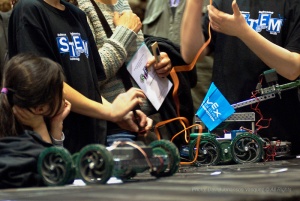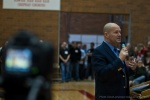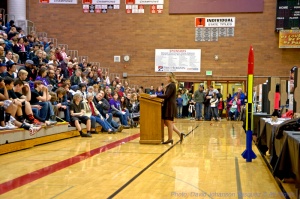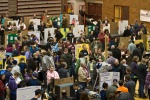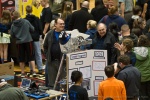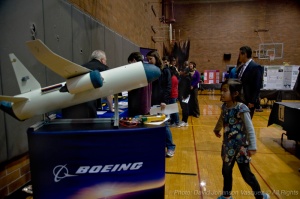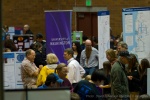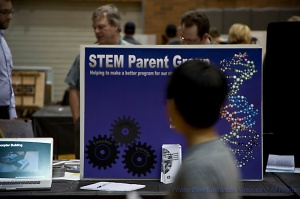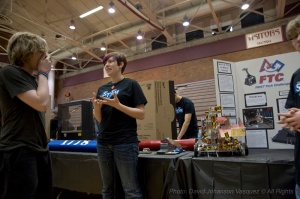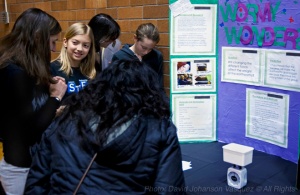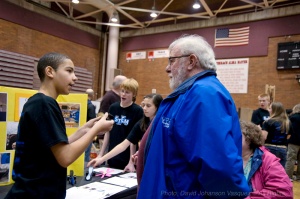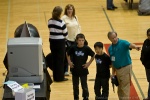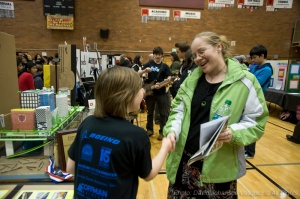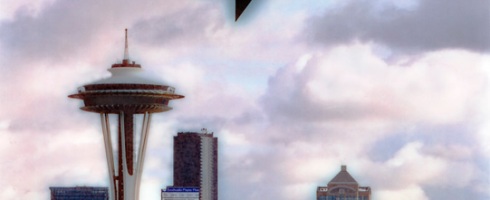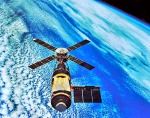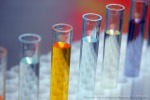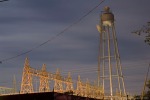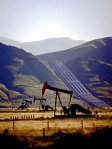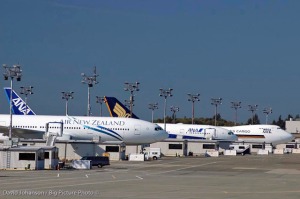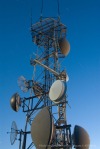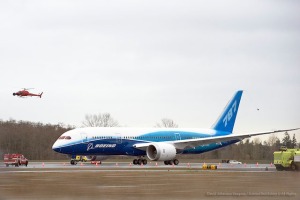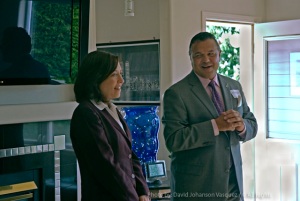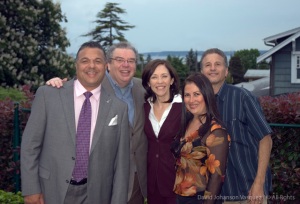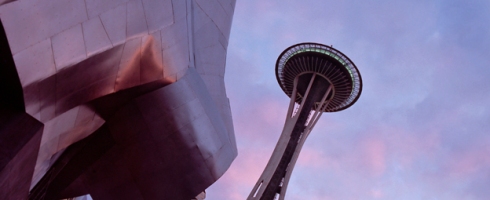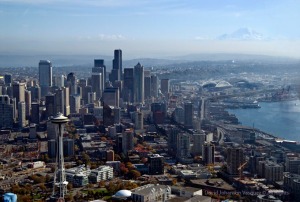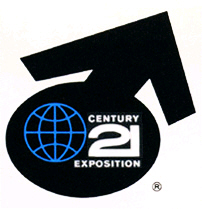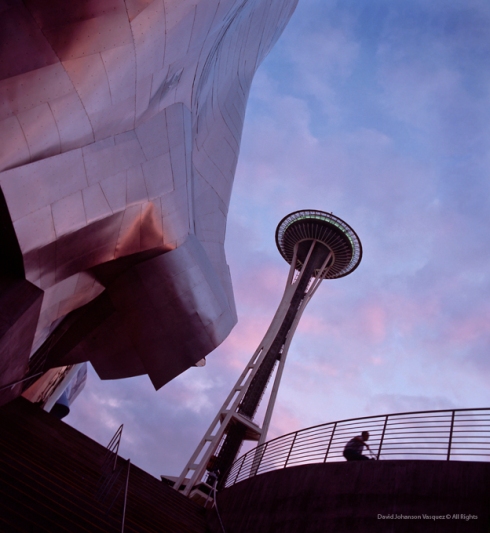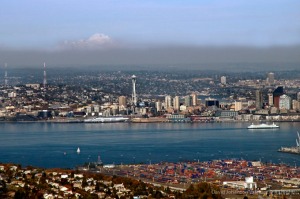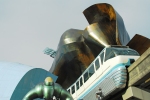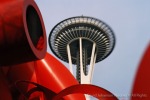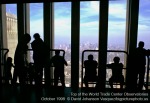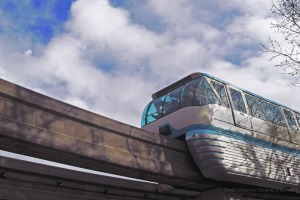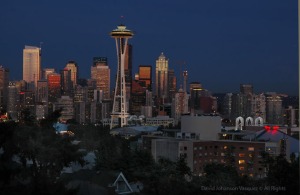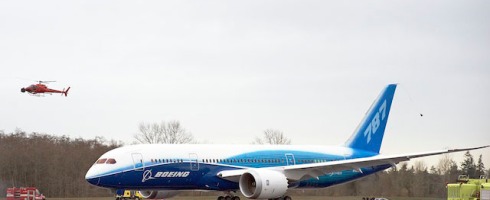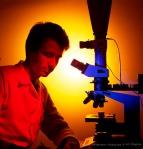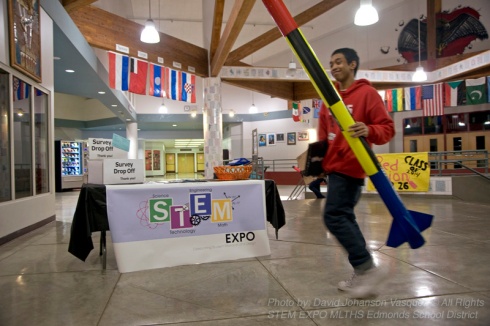
The first STEM EXPO Fair held at Edmonds School District’s new STEM Magnet School at MountLake Terrace HS in Washington State. This rocket club student is caring a rocket, which was used earlier in a group presentation at the fair.
Multimedia eLearning program by: David Anthony Johanson © All Rights
The author is a multimedia specialist, CTE instructor and a former Boeing scientific photographer. For an alternative graphic view of this program, please visit: https://bigpictureone.wordpress.com/2013/04/19/what-chance-will-americas-youth-have-in-a-changing-global-economy/
A big question asked by concerned people and industry leaders across the Nation is waiting for an answer… How will current and future generations stay competitive in an increasingly, complex, global economy? A high-performance education program involving a blend of Science, Technology, Engineering and Mathematics (STEM) — is promising solutions as its building momentum within post-secondary and kindergarten-through-grade 12 (K-12) education.
The dynamic learning created from STEM’s project based curriculum is contagious for a growing number of students. And the program’s appeal is spreading to parents, schools and corporate sponsors who are looking for ways to get involved in supporting technology learning through public education. Even the U.S. Congress solidly supports the critical initiatives driving STEM Education, which is mostly funded through the National Science Foundation (NSF.)
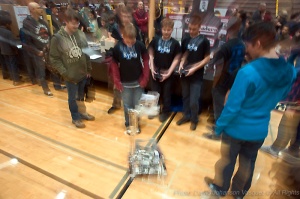
Enthusiasm and excitement was experienced by those viewing students’ technology project presentations.
A Basic Overview Of A STEM Magnet Program
By the 21st century, digital technology had transformed global industry and commerce by accelerating STEM related industries. The skill-sets, training and knowledge of entry-level applicants was falling behind. Standards for learning, used in our public educational system, were now becoming outdated. Nationally, educators needed a new, comprehensive learning approach to inspire, explore and motivate students’ achievement in the global dynamics of STEM.
Today, the Nation’s public schools place greater emphasis on introducing STEM related content to both teachers and students starting as early as grade school. This program strategy allows all students of varied backgrounds, ethnicities and socio-economic levels to gain access to learning projects associated with science and technology.
By presenting young students with thoughtful STEM lesson plans, they are more likely to engage in the discovery process of even the most technical subject matters. Entering middle school, students are learning accelerated levels of science and technology content, which helps them decide if they wish to enroll in a high school, offering a focused curriculum. The STEM Magnet Program pulls in a diversified population of students, engaged and motivated by their earlier learning experiences.
Evolution And Development Of STEM Education
Richard Blais, Chairman of the technology department for the Shenendehowa Central School District in Upstate New York, developed a curriculum in 1986, to support students’ interest in studying engineering. To enable enthusiasm and confidence in students, core courses included; pre-engineering and digital electronics, infused with energetic and interactive learning environments. The curriculum’s proven a success, attracted philanthropist, Richard Liebich, who partnered with Blais to set up, Project Lead the Way (PLTW.)
Within 10 years of PLTW’s founding, a dozen high schools in New York State adopted the program. Within the next few years high schools in 30 states were using PLTW’s “Pathway to Engineering Program.” Soon after, PLTW was a major national program, which used innovative activities of project and problem-based assignments. Further adding to PLTW’s momentum and success was the enthusiastic support corporations showed by endorsing and contributing financial resources towards the program.
STEM Education incorporated many successful PLTW learning strategies and programs. PLTW is still active in high schools today and plays an active role in STEM Education.
Mark Sanders’, 2009 STEMmania article in The Technology Teacher, cites the STEM acronym first being used in the 1990’s. The National Science Foundation (NSF) started using “SMET” as a reference for “science, mathematics, engineering and technology.” A department, program officer complained “SMET” sounded similar to “smut,” so “STEM” became the suitable replacement. It would take more than a decade for the public to recognize STEM’s referenced meaning.
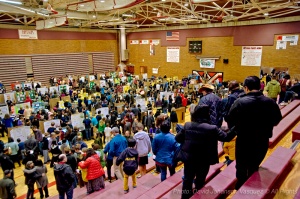
The support and enthusiasm for STEM Education is displayed by an impressive turnout for the District’s first STEM EXPO Fair.
The Challenge Of Integrative Education: Transcending Barriers And Perceived Domains Found Within Science, Technology, Engineering and Mathematic Education
Perhaps the greatest test for a STEM Magnet Program will involve achieving the goal, of course/subject integration. As a career, technical and education (CTE) instructor, I’ve heard this complaint more than any other from students — ‘why do I have to learn this subject, it doesn’t relate to other things I’m learning or anything I’ll ever need to know!?’ In truth, all subjects and courses taught in school share dynamic connections, we as educators need to do more in helping students see their associations.
 Core sciences and engineering education have traditionally maintained strict disciplinary lines, known as silos. This shortsighted disconnect is generally not found in industry, where the imperative is to find solutions which will “payoff” in the shortest amount of time. Industry’s necessity to cut through process for realizing greater profits is an important lesson plan for all STEM Programs. The realized profit for a student is — being taught how to quickly adapt new, comprehensive and sometimes-unconventional learning strategies to gain a competitive advantage.
Core sciences and engineering education have traditionally maintained strict disciplinary lines, known as silos. This shortsighted disconnect is generally not found in industry, where the imperative is to find solutions which will “payoff” in the shortest amount of time. Industry’s necessity to cut through process for realizing greater profits is an important lesson plan for all STEM Programs. The realized profit for a student is — being taught how to quickly adapt new, comprehensive and sometimes-unconventional learning strategies to gain a competitive advantage. 

The STEM Expo Robotics team takes a break from their demonstration for a group photo. Teamwork builds confidence and trust in the students themselves as well as other team members.
Benefits/Advantages For Both Students And The Schools They Attend
Developing a STEM magnet program helps a school district align its resources towards assisting students preparing for college and universities, which specialize in related technical studies. An additional advantage the program offers a student pursuing a post secondary education is — an institution will most likely accept the applicant’s enrollment request based on the knowledge and technical skills achieved through a STEM Magnet Program.
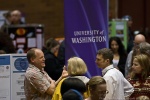
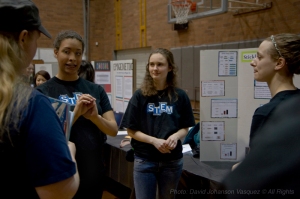 U.S. industries have increasingly cited the lack of qualified technical applicants they need as a reason not to hire more employees. The shortage of people with necessary STEM skills has motivated corporations to contribute their resources of funding, mentoring and sponsorship towards public education’s technology learning programs.
U.S. industries have increasingly cited the lack of qualified technical applicants they need as a reason not to hire more employees. The shortage of people with necessary STEM skills has motivated corporations to contribute their resources of funding, mentoring and sponsorship towards public education’s technology learning programs.
Parents and community groups have eagerly supported STEM programs. Student’s parents are critical stakeholders who quickly realized the impact the program was having — seeing impressive scholastic and attitude improvements with their children.
STEM Education Uses Progressive Learning Strategies To Develop Critical Learning And Self-Discipline Within Students
STEM Education attempts to accelerate student development by modifying the standard teacher-centered classroom with more independent learning. The curriculum encourages project-based learning, problem solving and discovery, which empower the students to engage their cognitive skills to find solutions. This form of learning develops greater self-confidence in students and it opens channels among the students themselves to interact thru peer-to-peer learning. These spontaneous collaborative activities are self-organized learning events and they naturally promote leadership within the group. It has been well documented, knowledge transferred from experience in peer-to-peer activities are highly successful forms of learning.
Tangible Returns In Personal Development Through Teamwork And Leadership
Over the past five years I’ve had the opportunity to teach in a variety of classroom environments using a CTE curriculum. It’s remarkable seeing how engaged students are with learning their STEM subject matter. These same students are much more likely to openly contribute and share their ideas in a classroom discussion using the critical thinking skills they’ve learned to develop.
Most often, STEM classes are more like being in a college environment, requiring a minimum amount of classroom management, as the students are self-motivated to complete their assignments and move on to the next project. Generally the level of leadership development and volunteerism is noticeably higher in STEM classes due to the program’s emphasis on teamwork, self-confidence and academic achievement. These personal development qualities are valuable assets for students applying for college admission and later — when entering the career of their choice.
Improving Forecast For Employment Opportunities Using STEM Education
As STEM Magnet Schools continue to place their graduates into secondary education, followed by the students’ successful careers in STEM related industries — STEM Education will help transform the American education landscape. If STEM Education can sustain its momentum, the future horizon looks bright for our youth to achieve economic opportunities on a global leveled playing field. 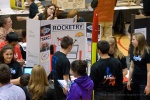
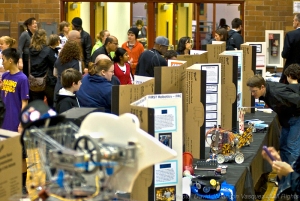
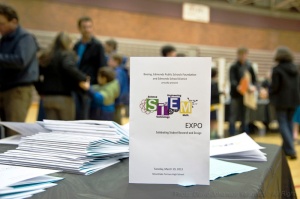
.
STEM Education Terms & Definitions
CTE = Career Technical Education NSF – National Science Foundation PD&I = pedagogy referring to – purposeful design and inquiry PLTW = Project Lead The Way STEM = Science, Technology, Engineering & Mathematics STEM Magnet School = A school with a concentration of STEM classes, which attracts students throughout a school district interested in enrolling in a STEM Program 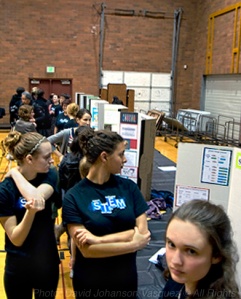
STEM Education Links
http://www.stemedcoalition.org/ Home The Future of Education / The history of STEM education in America. Handy infographic! What is STEM Education? PLTW | OUR HISTORY PLTW | STEM Education Curriculum for Middle and High Schools http://esdstem.pbworks.com/f/TTT%2BSTEM%2BArticle_1.pdf Home PBS Teachers | STEM Education Resource Center nsf.gov – National Science Foundation – US National Science Foundation (NSF) Siemens STEM Academy – STEM Education Has Arrived… Start Small, But Dream Big http://www.stemeducation.com/ STEM Resources | Early STEM Program Still Going Strong – STEM Education (usnews.com) What STEM Is–and Why We Care – STEM Education (usnews.com) https://education.uky.edu/STEM/sites/education.uky.edu.STEM/files/SEM%20604_syllabus_%20History%20of%20STEM%20Ed.pdf Historical Perspectives on STEM Education in Arkansas | Arkansas STEM Coalition http://www.fas.org/sgp/crs/misc/R42642.pdf STEM ES Home – STEM ES FAQs NSTA :: News Story

